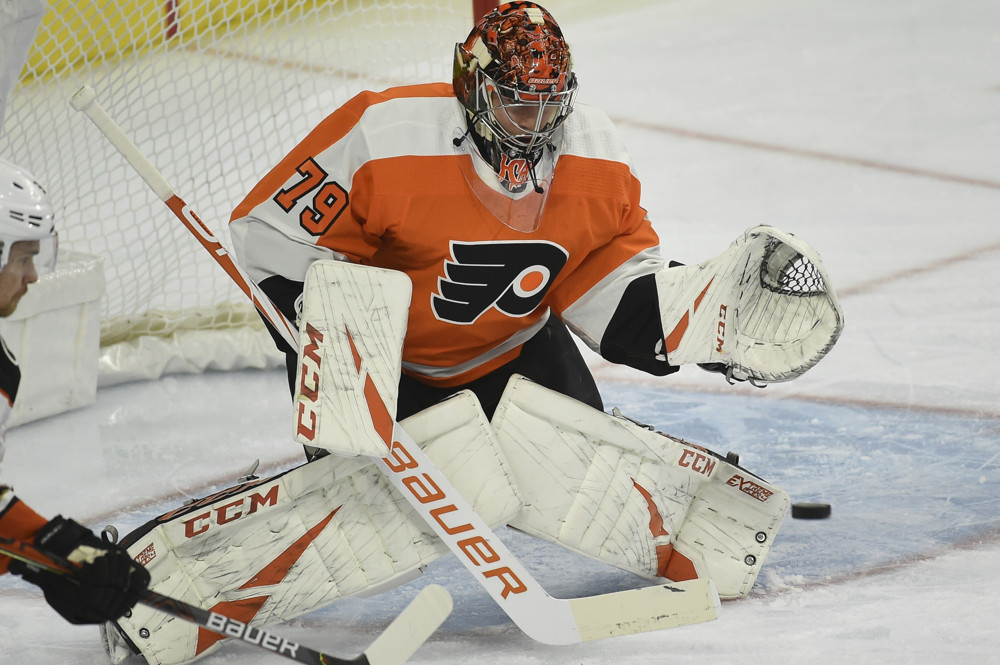Philadelphia Flyers’ Patience Paying Off vs. Islanders
It doesn’t have to be pretty. It just needs to work.
The Philadelphia Flyers have sworn by this strategy in the postseason. After edging out the Montreal Canadiens despite owning just 34.1% of the high-danger chances and 39.7% of the expected goals, they’ve now battled back from a 3-1 series deficit to force Game 7 against the New York Islanders in Round 2.
Much like in the conference quarterfinals, Alain Vigneault’s men aren’t driving the majority of the play. Through six contests, they’ve posted a 40.6 HDCF% and 46.1 xGF%. Since they’ve yet to score a power-play goal across the entire series, their margin of victory is thinner than ever.
However, they’ve managed to keep reaping the rewards of their defensive-to-a-fault approach. It’s not as though they suffocate their opponents either. In fact, only one club (Chicago) has allowed quality looks at a higher rate than the Flyers since the start of the first round. Philadelphia has presented the Islanders with a healthy dose of rope-a-dope, shelling up and inviting their pressure for most of regulation only to hit them with stiff counterattacks. It couldn’t quite land the winning blows early in the matchup, but it’s connected in the past two outings to the tune of nine goals.
More importantly, the Flyers are consistently generating this offense with the game up for grabs. All three of their wins in this series have come in extra time.
If Game 7 remains tied after three periods, Philadelphia will undoubtedly hold the upper hand. It has already proven its clutch abilities, whereas Barry Trotz’s squad is finding ways to lose.
That begins in the crease.
On the surface, the numbers suggest there isn’t much separating Semyon Varlamov (2.59 GAA, 89.9 SV%) and Carter Hart (2.78 GAA, 90.9 SV%). Upon closer inspection, it’s clear the 22-year-old has outplayed the veteran. The Flyers’ high-danger save percentage (87.7) ranks first in the second round, which has allowed them to control 40.6% of the high-danger attempts but 53.3% of the high-danger goals. Meanwhile, the Islanders’ HDSV% (80.5) sits in the middle of the pack. Among starters, Hart sits first in high-danger goals saved above average. Varlamov is dead last in that department. In a nutshell, Philly’s netminder has provided a considerably stronger last line of defense.
On Thursday night, Hart rose to the occasion yet again in overtime. First, he tracks a bounce from a point shot and stones Islanders captain Anders Lee in tight:
Then he repels Mathew Barzal on a nifty deflection off the rush:
While Hart wasn’t flawless on the night, he brought a sense of calm between the pipes. He appeared locked in and had a bead on the puck throughout the game, ultimately finishing with 49 saves on 53 shots.
Varlamov, on the other hand, was erratic and undependable. Even though he boasts 40 career playoff appearances, the 32-year-old couldn’t seem to find his comfort zone, conceding juicy rebounds that led to mad scrambles in the goalmouth area. It felt as though there was disaster waiting around every corner.
His depth was off the entire game as well. On Michael Raffl’s 3-3 goal, he sags too deep and away from the play, affording the winger an easy tap-in:
On Ivan Provorov’s game-winner, he flips the script and compromises his own vision by hugging the screener:
There’s no question that the Islanders can feel those nerves, and that has cast some doubt over their ability to close out this series. Continually coming so close and losing in sudden death is affecting their resolve and compelling them to press the issue for offense rather than letting the chances come to them. As a result, we’ve seen a much sloppier team in the past two contests.
Trotz, who is considered perhaps the single finest coach in the league, has failed to reel his group in. The energy and hunger are still there, but the focus guiding them has been replaced with sheer desperation.
In Game 6, the uncharacteristic mistakes came early and often.
During a routine three-on-three situation, Leo Komarov and Scott Mayfield claim the same Flyer (Travis Konecny). Konecny recognizes this and quickly dishes to Kevin Hayes to open the scoring:
Not even two minutes later, defensive blueliner Adam Pelech flies off the handle and decides to take on the opposition by himself. Josh Bailey taps the loose puck back to no one in particular and the ensuing confusion places James van Riemdsyk in prime shooting position for the 2-0 marker:
After the Islanders wrestled back the lead, typically reliable defenseman Devon Toews fumbles the puck at the offensive blue line and gets trapped in no man’s land. He doesn’t smother the puck-carrier (Claude Giroux) or offer any resistance in the passing lane. Scott Laughton, Philadelphia’s overtime hero in Game 5, is thus gifted a breakaway and makes no mistake:
This would be an egregious error under normal circumstances, but consider the context: New York was sitting on a one-goal lead at the end of a power play. If there was ever a time to be safe rather than sorry, this was it. Instead, a club that seldom gives opponents anything for free gave the game away.
Philadelphia has regained its footing on the back of such blunders. With the conference finals at their fingertips, the Islanders have repeatedly dropped the ball. The Flyers, for their part, have run with it and come up large in the biggest moments. Even without two-way pillar Sean Couturier (lower-body injury) on Thursday, they dug deep to force a seventh and deciding game.
Philadelphia is indeed absorbing an almighty wallop from the Islanders, but it isn’t cowering and waiting for the other shoe to drop. It’s waiting for the Islanders to punch themselves out.
And it seems to be working.
Recent Posts

How Corey Perry Is Making His Presence Felt With the Lightning
View Post »
How Adam Fox Pushed the Rangers Past the Penguins
View Post »

